
A Molotov cocktail, also known as a petrol bomb, gasoline bomb, bottle bomb, poor man's grenade, fire bomb, fire bottle or just Molotov, sometimes shortened as Molly, is a generic name used for a variety of bottle-based improvised incendiary weapons.

A nuclear weapon is an explosive device that derives its destructive force from nuclear reactions, either fission or from a combination of fission and fusion reactions. Both bomb types release large quantities of energy from relatively small amounts of matter. The first test of a fission ("atomic") bomb released an amount of energy approximately equal to 20,000 tons of TNT (84 TJ). The first thermonuclear ("hydrogen") bomb test released energy approximately equal to 10 million tons of TNT (42 PJ). Nuclear bombs have had yields between 10 tons TNT and 50 megatons for the Tsar Bomba. A thermonuclear weapon weighing little more than 2,400 pounds (1,100 kg) can release energy equal to more than 1.2 million tons of TNT (5.0 PJ). A nuclear device no larger than traditional bombs can devastate an entire city by blast, fire, and radiation. Since they are weapons of mass destruction, the proliferation of nuclear weapons is a focus of international relations policy.

The Oklahoma City bombing was a domestic terrorist truck bombing of the Alfred P. Murrah Federal Building in Oklahoma City, Oklahoma, United States, on Wednesday, April 19, 1995. Perpetrated by anti-government extremists Timothy McVeigh and Terry Nichols, the bombing happened at 9:02 am and killed at least 168 people, injured more than 680 others, and destroyed more than one-third of the building, which had to be demolished. The blast destroyed or damaged 324 other buildings within a 16-block radius, shattered glass in 258 nearby buildings, and destroyed or burned 86 cars, causing an estimated $652 million worth of damage. Local, state, federal, and worldwide agencies engaged in extensive rescue efforts in the wake of the bombing. The Federal Emergency Management Agency (FEMA) activated 11 of its Urban Search and Rescue Task Forces, consisting of 665 rescue workers who assisted in rescue and recovery operations. Until the September 11 attacks in 2001, the Oklahoma City bombing was the deadliest terrorist attack in the history of the United States other than the Tulsa race massacre. It remains one of the deadliest acts of domestic terrorism in U.S. history.
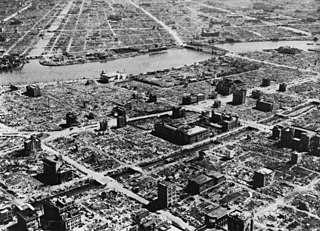
Strategic bombing is a military strategy used in total war with the goal of defeating the enemy by destroying its morale, its economic ability to produce and transport materiel to the theatres of military operations, or both. It is a systematically organized and executed attack from the air which can utilize strategic bombers, long- or medium-range missiles, or nuclear-armed fighter-bomber aircraft to attack targets deemed vital to the enemy's war-making capability.

Hiroshima is the capital of Hiroshima Prefecture in Japan. As of June 1, 2019, the city had an estimated population of 1,199,391. The gross domestic product (GDP) in Greater Hiroshima, Hiroshima Urban Employment Area, was US $61.3 billion as of 2010. Kazumi Matsui has been the city's mayor since April 2011.

The Avro Lancaster is a British Second World War heavy bomber. It was designed and manufactured by Avro as a contemporary of the Handley Page Halifax, both bombers having been developed to the same specification, as well as the Short Stirling, all three aircraft being four-engined heavy bombers adopted by the Royal Air Force (RAF) during the same wartime era.

The Heinkel He 111 was a German bomber aircraft designed by Siegfried and Walter Günter at Heinkel Flugzeugwerke in 1934. Through development it was described as a "wolf in sheep's clothing". Due to restrictions placed on Germany after the First World War prohibiting bombers, it masqueraded as a civil airliner, although from conception the design was intended to provide the nascent Luftwaffe with a fast medium bomber.

An improvised explosive device (IED) is a bomb constructed and deployed in ways other than in conventional military action. It may be constructed of conventional military explosives, such as an artillery shell, attached to a detonating mechanism. IEDs are commonly used as roadside bombs.
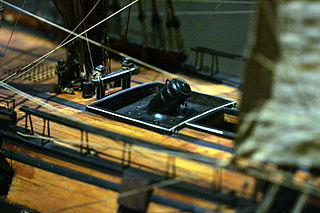
A bomb vessel, bomb ship, bomb ketch, or simply bomb was a type of wooden sailing naval ship. Its primary armament was not cannons – although bomb vessels carried a few cannons for self-defence – but mortars mounted forward near the bow and elevated to a high angle, and projecting their fire in a ballistic arc. Explosive shells or carcasses were employed rather than solid shot. Bomb vessels were specialized ships designed for bombarding fixed positions on land. In the 20th century, this naval gunfire support role was carried out by the most similar purpose-built World War I- and II-era monitors, but also battleships, cruisers and destroyers.
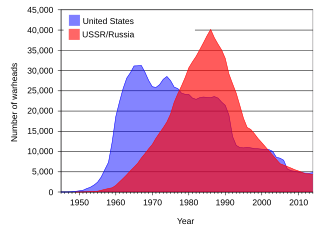
The nuclear arms race was an arms race competition for supremacy in nuclear warfare between the United States, the Soviet Union, and their respective allies during the Cold War. During this same period, in addition to the American and Soviet nuclear stockpiles, other countries developed nuclear weapons, though none engaged in warhead production on nearly the same scale as the two superpowers.

Strategic bombing during World War II was the sustained aerial attack on railways, harbours, cities, workers' and civilian housing, and industrial districts in enemy territory during World War II. Strategic bombing is a military strategy which is distinct from both close air support of ground forces and tactical air power.
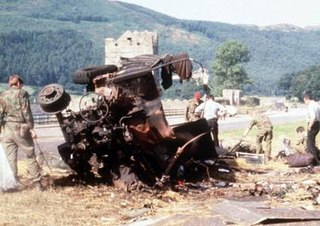
The Warrenpoint ambush, also known as the Narrow Water ambush, the Warrenpoint massacre or the Narrow Water massacre, was a guerrilla attack by the Provisional Irish Republican Army (IRA) on 27 August 1979. The IRA's South Armagh Brigade ambushed a British Army convoy with two large roadside bombs at Narrow Water Castle outside Warrenpoint, Northern Ireland. The first bomb was aimed at the convoy itself, and the second targeted the incoming reinforcements and the incident command point (ICP) set up to deal with the incident. IRA volunteers hidden in nearby woodland also allegedly fired on the troops, who returned fire. The castle is on the banks of the Newry River, which marks the border between Northern Ireland and the Republic of Ireland.

The Harrods bombing refers to the car bomb that exploded outside Harrods department store in central London on Saturday 17 December 1983. Members of the Provisional IRA planted the time bomb and sent a warning 37 minutes before it exploded, but the area was not evacuated. The blast killed three police officers and three civilians, injured 90 people, and caused much damage. The IRA Army Council claimed it had not authorised the attack and expressed regret for the civilian casualties. After the bombing, the IRA shifted its emphasis towards attacks on military targets on the mainland.

The United States detonated two nuclear weapons over the Japanese cities of Hiroshima and Nagasaki on August 6 and 9, 1945, respectively. The two bombings killed between 129,000 and 226,000 people, most of whom were civilians, and remain the only use of nuclear weapons in armed conflict.

The Cádiz Memorial, also known as the "Prince Regent's Bomb", is an early 19th-century French mortar mounted on a brass monster, located in Horse Guards Parade in Westminster, London. It was first "exposed to public view" on 12 August 1816 and has been classified as a Grade II listed building since 1 December 1987. The monument was a feature of many satirical verses and cartoons in the early 19th century, mainly because the word "bomb" – pronounced "bum" – gave it an immediate association with the notoriously profligate Prince Regent's sizeable backside.
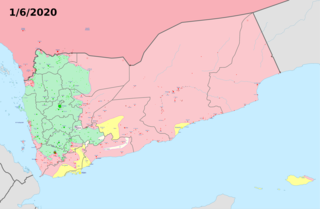
The Saudi Arabian-led intervention in Yemen is an intervention launched by Saudi Arabia on 26 March 2015, leading a coalition of nine countries from West Asia and North Africa, in response to calls from the pro-Saudi president of Yemen Abdrabbuh Mansur Hadi for military support after he was ousted by the Houthi movement due to economic and political grievances, and fled to Saudi Arabia.

On 24 April 1996, the Provisional IRA planted two powerful bombs underneath Hammersmith Bridge in west London. Although the detonators caused two small explosions, the bomb itself failed to explode. The bomb was located on the south side of the bridge and contained 30 lb of Semtex high explosives, which according to an explosives expert had the ability to blow up the entire bridge. The IRA gave two telephone warnings, the first at 22:22. Police located the device afterwards before it caused small explosions around 22:50. Scotland Yard said it was "meant to kill, cause injury and major structural damage to Hammersmith Bridge".

The Red Lion Pub bombing was a bomb attack that happened on 2 November 1971 in Belfast, Northern Ireland. Planted by the Provisional IRA's Belfast Brigade, it exploded in the Red Lion pub, killing three people and injuring about 30 others.

A suicide bombing occurred on Wednesday 15 August 2018 in a Shia-populated area of Kabul. Afghanistan's Ministry of Public Health reported that 48 people including 34 students were killed and 67 were injured. The responsibility was claimed by ISIS.
On 24 July 2017, a suicide car bombing occurred in Kabul, Afghanistan. It happened during morning rush hour in a Shia neighbourhood in the west of the city. The bomber rammed the car into the side of a bus which was transporting government employees to work. At least 35 people were killed and dozens of others injured. The bombing destroyed the bus, three other vehicles and several businesses. The Taliban claimed responsibility for the attack.



















